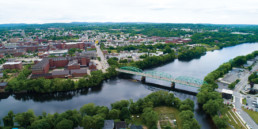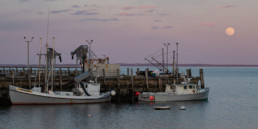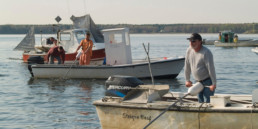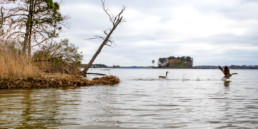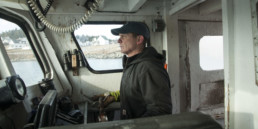How Two French Islands Recovered, Post-Cod
Saint-Pierre et Miquelon were squeezed before and during cod moratorium
story and photos By Natalie Springuel
I am standing atop Le Belvédère, a commanding scenic viewpoint overlooking the town of Saint-Pierre, the population center of the French territory and archipelago known as Saint-Pierre et Miquelon. Beyond its harbor and breakwaters, over a mere 25 miles of North Atlantic seas, it is not the European foothills I see but the mountains of Newfoundland’s south coast, in Canada.
The view is stunningly beautiful. The sea is slate blue, the sky endless. Around me, low to the ground, fall colors—reds, rusty oranges, and brilliant evergreens—explode in this boreal maritime environment of stunted vegetation. The land and seascape look so much like Newfoundland, but the words of a young woman fisherman I interviewed a few days ago caution, “Don’t forget we are on a little piece of France here, on the other side of the Atlantic.”
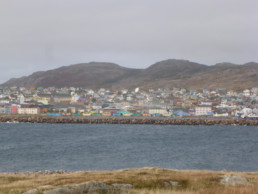
Le Belvédère de l’Anse à Pierre offers an endless view with the town of Saint-Pierre below.
I use my binoculars to investigate the scene below, the waterfront, the boats, the colorful “salines,” salt houses used to process cod up until the 1992 Canadian cod moratorium. I wonder, for the hundredth time, what was it like for these folks, French citizens on a tumble of rocks that anyone could be forgiven for thinking was part of Newfoundland, to live through the cod moratorium? Was it just as devastating as Newfoundland? Did they also lose their economy, their cultural bearings, and spill into a sea of unemployment and outmigration?
I had been studying the impact of the cod moratorium in Newfoundland for nearly 15 years and could count among my friends Newfoundlanders who had lived through those dark times and come out at the other end with hope for the future. But it had been hard, no doubt about it. This time I wanted to understand the impact of the moratorium on the 6,000 or so French citizens of Saint-Pierre et Miquelon.
The archipelago represents the last bastion of the French empire in North America. It was jostled between French and British control multiple times during the centuries of conflict for conquest of the New World. The archipelago’s strategic location made it ideally suited to serve as a base for the Grand Bank fishery. In 1815, as a result of the Treaty of Vienna, Saint-Pierre et Miquelon became, “une fois pour toute” (once and for all) a bona fide French territory, while Newfoundland remained British until it joined Canada in 1949.
Fast forward to the 1970s. France’s and Canada’s claims for territorial seas, or “exclusive economic zones” extending 200 nautical miles from shore, conflicted. Two decades later, the International Tribunal Court of Arbitration settled Saint-Pierre et Miquelon’s EEZ at a mere 24 miles around the archipelago, with the exception of a 10.5-mile-wide swath extending 200 miles south.
The ruling, a blow to French fishing rights, was compounded by the equal or worse blow imposed by the Canadian cod fishing moratorium in the waters surrounding Newfoundland, where the French government had counted on acquiring fishing quota to keep its own fleet afloat. Coastal communities in both lands witnessed the disastrous end of an era. Overnight, thousands of people found themselves out of work. Both economies came to a grinding halt, uniting the people by their shared crisis.
Today, it is apparent that Canada and France picked up the pieces in very different ways, producing neighboring societies that are strikingly distinct.
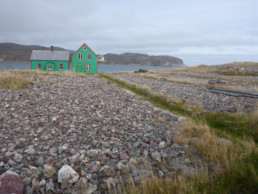
L’Île aux Marins, a 10 minute ferry ride from Saint-Pierre, was once home to hundreds of cod fishing families who dried their catch on gravel beds maintained mostly by children.
In Newfoundland, the government response included offering payments and retraining programs for those put out of work, along with regional community development strategies aimed at fostering business innovation. Well-meaning as these programs were, outmigration was massive and many Newfoundland outports lost up to half of their population to the “tar sands” of Alberta and other places with the promise of work.
Paradoxically, Saint-Pierre et Miquelon’s population remained remarkably stable with employment shifting to other sectors. During my fall 2019 visit, homes appeared lived in, lights were on, people had jobs, retirement pensions, medical coverage, and an apparent lack of social need. I was not seeing neighborhoods losing residents to outmigration. On the contrary, people were coming here to work! I met people from “La Metro” (continental France) working in bakeries, hotels, restaurants, government posts, and even as deckhands in the fishery, like the young woman who had come for a job on a groundfish trawler.

Tourism, focused on the archipelago’s rich fisheries heritage and maritime environment, is an important strategy in the French government’s plan for Saint-Pierre et Miquelon’s future. This image was shot on L’Île aux Marins, and the steel map represents that island.
How could it be that Saint-Pierre et Miquelon had jobs aplenty while Newfoundland outports had so few? France’s response to the fisheries crisis, it turns out, was to activate government support on a scale that was simply inconceivable in North American countries.
By some accounts, government now provides for more than half the archipelago’s economy in the form of administrative jobs with local government, and federal subsidies for various enterprises such as the hospital and the electric company. Many of the people I encountered were in positions supported in some way by federal and territorial government: airport and port crews, construction workers, radio personalities. Americans, my new French friends scoffed, will dismiss such widespread government support as socialism; but isn’t it, as they insisted, just the French government taking care of its people?
I could not help but think that this society seems to have weathered a storm that Newfoundland is still untangling. But it was not that simple. Several business owners worried that people have become complacent, assuming their kids will grow up, get a job with “l’administration,” and live the same standard of living they enjoyed. The comparatively high level of administrative backing seems to have unleashed an era of dependence. Some Saint-Pierrais I met were concerned that government investment is never guaranteed. The whims of European politics could change everything.
Not all view dependence on La Metro as a sustainable path going forward. Even the territory’s government officials recently announced on La Première, the local branch of national television, the need for economic diversification, and tout tourism as one solution. Indeed, the archipelago’s natural and cultural assets truly are unparalleled, and cruise ship visits are on the rise.
But one hotel and restaurant owner I spoke with struggled to find young employees to fill the jobs required in the service sector. With so many comfortable in their government jobs, the labor shortage is acute. This explains, in part, why even bakery workers, garage door installers, and, most ironic given the archipelago’s maritime history, fishing boat crew are imported.
~
One rare entrepreneur I met observed that the initiative needed to diversify the economy away from the French umbilical cord is extremely uncommon. Most people just don’t want to take the risk of venturing into the private sector. But what does that do for the businesses that are necessary to keep society functioning? What does that do for private investment? What does that do for entrepreneurialism and innovation?
Back in 2008, when I lived in Newfoundland for six months, Newfoundlanders bemoaned their government’s reliance on social enterprise for pulling society back up. Newfoundlanders, having lived for centuries dependent on cod, had never developed the business capital, the skills, or even the mental disposition for entrepreneurialism to be a real option, they said.
But now, 27 years post-moratorium, as Newfoundland slowly emerges from economic and social collapse, a sense of entrepreneurialism is taking root. Microbreweries, award-winning museums, world-class hotels, a growing foodie scene, all are examples of the solutions Newfoundlanders are putting into place to breathe life back into their communities.
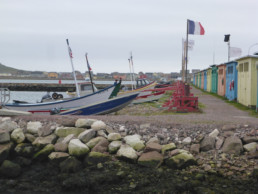
“Les Salines” or salt houses, where dory fishermen processed their catch and maintained their boats.
Often, it is the now-adult kids of those put out of work by the cod collapse who are picking up the pieces. It has not been without cost: thousands lost to outmigration and the shattering of a centuries old identity. Challenges remain for sure, but Newfoundland in 2019 feels, as they say, “on the go.”
~
Back up on Le Belvédère overlooking the town, I take a deep breath as I scan Newfoundland in the distance and notice the small cruise ship steaming out of the Saint Pierre harbor. It is my last day on the island. I turn, facing southwest, and look across the sea. My thoughts turn to Maine. I can’t help but wonder: how would Maine fare if the lobster fishery crashed? Would the aftermath be as powerful as the cod crisis has been on the colorful town beneath my feet? Would it be as catastrophic as it was on the Newfoundland outports below those mountainous silhouettes across the sea? It is hard not to draw cautionary lessons.
How would we react if lobster really declined? Would we choose to take a more Canadian approach and attempt to boost regional development while counting on market forces to usher in new industries, but risk a declining population? Or would we choose the French approach of assuaging economic crisis with an outpouring of government jobs and subsidies, while risking a dependent population?
I will admit that in my comparison of the two, I found France’s commitment to the permanence of the archipelago’s population, whatever investment that might take, a hopeful counterpart to Newfoundland’s outmigration crisis, especially at first. But the realities on the ground, in both cases, led me to see that both approaches have some promise and some pitfalls for regions like Maine, where uncertainty about our future fisheries looms over any planning for a sustainable future for our coastal communities.
Maine’s coastal economy, except perhaps Washington County’s, has the advantage of greater diversity to begin with. Public-private partnerships are part of how we function. I think of examples like federal grants to our burgeoning aquaculture sector, non-profit loans to small or women-owned businesses, and regional partnerships for tourism development.
One thing is certain though: if Maine ever experiences a dramatic downturn in the lobster economy, Maine’s coastal communities will undoubtedly change. Unanticipated change can come fast and furious, leading to crisis and crisis response that can have an impact on the trajectory of entire societies for decades hence. But change can also usher in new ideas, creative adaptations, and potentially better ways of doing things. It is how we respond that will make all the difference.


